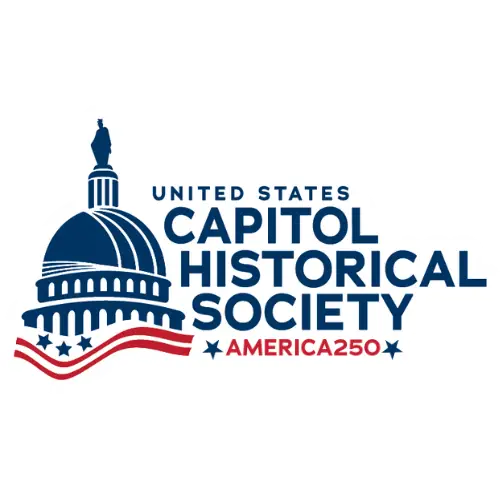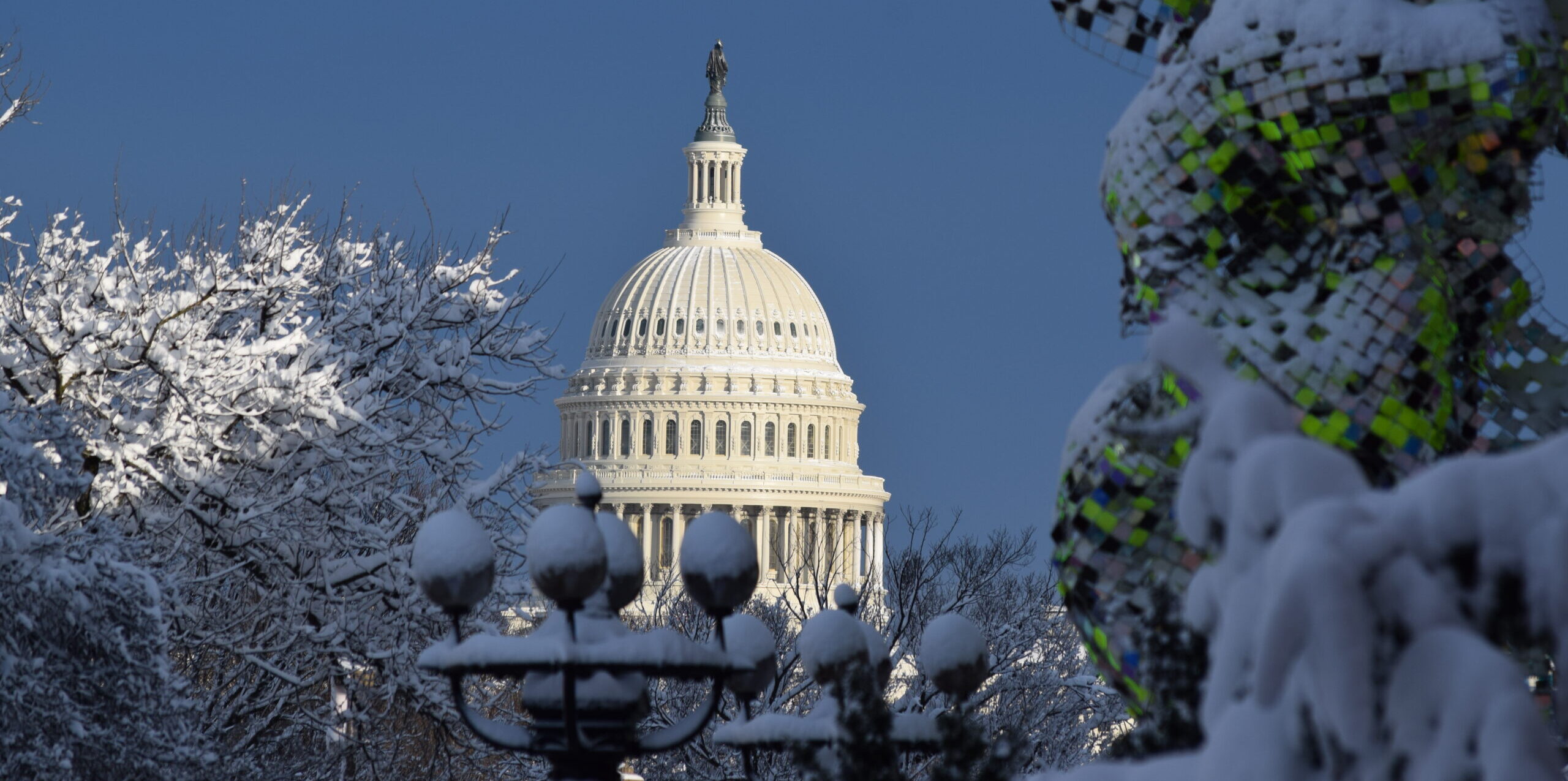Clarence Mitchell, Jr: American Radical
By Joshua Zampetti
August 7, 2017
Completed during the Clarence J. Brown Graduate Internship. Unless otherwise noted, images are courtesy the Mitchell Family.
Introduction: The Path Taken
“All history resolves itself very easily into the biography of a few stout and earnest persons.” – Emerson
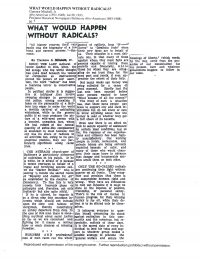
The truest path to justice is by exhibiting in oneself what ought to be exhibited in society. However, in societies with republican governments, if a collective majority of self-interests comes to predominate policy, then the freedom of excluded individuals will become stifled, and the resulting fissures will ultimately serve to provoke factional violence and oppression. The goal of civilized society, therefore, ought not to be in service of petty self-interest; it ought to protect the interests of everyone in their personal “pursuit of happiness,” and should recognize and respect what we each want for ourselves: the opportunity to provide for oneself and one’s family, free access to those fruits of society that educate and govern, and a life of dignity. This is the example that Clarence Mitchell would set. Throughout his struggle, Clarence Mitchell remained fixed to his convictions, and by exemplifying his principles through his actions he won the respect of many in positions of power and assisted in swaying them toward instituting those principles into law. He understood that the institutions already in place were designed to promote justice, it was simply a matter of convincing the leaders of those institutions that they ought to be freely conducted, uncorrupted by self-interest and fully representative, and focused on providing equal opportunity for all, as it is the only true way to instill liberty into a nation. His decision to work within those designs, instead of against them, would inevitably set the example of how the ideals of American government can be achieved.
The institutional struggle would prove to be challenging. The temptation to service self-interest through government is not only considerable but prone to instigating violence. When Mitchell wrote “What Would Happen without Radicals” for the Baltimore Afro-American in 1933, he opened the article in cryptic fashion, describing an “old savage” buried beneath the “veneer of civilization,” who “destructively proved his powers of self-assertion.” He is likely referring to Gavrilo Princip, the member of the radical Black Hand society, whose assassination of Archduke Franz Ferdinand sparked the conflict. It may have been more applicable, however, for Mitchell to have mentioned Leon Czolgosz, a socialist and the assassin of President William McKinley just thirteen years prior to the outbreak of the war. Czolgosz’s last words: “…I did it because I thought it would benefit the poor people and for the name of the working people of all nations…”[1] While both Princip and Czolgosz indeed depict the savagery Mitchell describes, Czolgosz’s crime is closer to home, and his motives decry civilization’s “veneer” regarding the struggling, working poor—issues that Mitchell would take on himself throughout his career. But Czolgosz’s act never served to enact much change. Violent acts such as this are often the result of impulsiveness due to a lack of discipline, making it an act of weakness, not of strength, and the perception of the public often works to rally around the victim, not the offender. The aim of this impulsiveness, driven by overwhelming emotion, is to silence—either an individual or even a movement—whose message is perceived to undermine one’s identity, particularly an identity within a specific community. The challenge, for each and every one of us, is to achieve a balance within the dual meaning of self: a healthy self-regard can wander from principled self-respect to a corrupt self-interest. Without a firm discipline, each of us can become lost in arrogance or selfishness, and the stronger these emotions work to overwhelm us, the greater the risk of violent impulsiveness.
JFK once said that “Those who make peaceful revolution impossible will make violent revolution inevitable.”[2] While there was certainly violence during the civil rights movement of Kennedy’s time, it was not the violent acts that ultimately forwarded lasting change. In fact, it was truer of the opposite: those violent acts often consolidated the conviction of those on the opposing side with a higher moral authority, and what won the heart of the nation were those principles that transcended the self-interest along color lines. Some of the most inspiring figures in the movement did not commit acts of violence; instead they made use of their principles to convince the nation what was right, and they used those instruments of American justice to promote those principles, hijacked as they were at the time to promote self-interest and injustice.
At only 22, Clarence Mitchell, Jr. was not likely considering himself when he used the above quote from Emerson in his article on radicalism in 1933. But the role he played in the civil rights movement, in the turbulent and pivotal twentieth century, while less dramatic than that of Dr. King, was probably more fundamentally necessary on practical grounds. Ours is a nation of laws, a nation of institutions, and even when one becomes disillusioned with those institutions, as Mitchell did in those early years, one can still find a course for redress if the system is truly just—even if many of the members of that system are not.
An Attempt at Representation
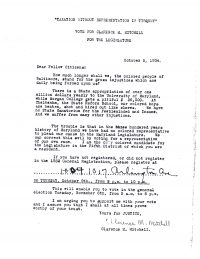
After 1933, Mitchell would have to decide which form of radicalism his life would take: that of quick, impulsive violence, or that of institutional struggle. He chose to display his faith in the democratic process by running for the Maryland General Assembly in 1934. In his campaign voucher, pleading with other African-Americans to get registered and vote, he explained, “The trouble is that in the three hundred years history of Maryland we have had no colored representative to plead our cause in the Maryland Legislature.” Mitchell’s candidacy on the Socialist ticket revealed his distrust for the two major parties, as well as his commitment to working folks. Even during the New Deal, the prospects for black workers in Baltimore were slim. In an environment of intense labor competition, black workers faced equally intense discrimination, both from white workers and employers. Mitchell understood that it was the policy that had to change: one toward protection of black workers and the enforcement of that protection. As Ryan Matthews put it in his endorsement of Mitchell[3] in the Afro-American in October of 1934:
“A man who goes into the legislature with a majority party ceases to be an individual and simply becomes another ‘Yes’ or ‘Nay’ as the bosses dictate. The man who stands alone can vote alone and usually an honest man, unhampered by party ties and obligations, will vote on the right side of a question instead of the expedient side only. Most of our wrongs have been heaped upon us by expedient voters. The protecting mantle of a political party does things to a man’s conscience that make him stoop to tricks that he would not dare do as an individual.”
In this respect, white groupthink in the legislative body, along with the ability to hide individual accountability, can lead to a misappropriation of justice toward the interests of whites and whites alone. It is why representation is so important in the American system, which is why it is no coincidence that black voting rights were so attacked following the 15th Amendment.
Mitchell’s voucher begins with the phrase “Taxation without Representation is Tyranny,” applying the old Revolutionary motto to the black cause, but for African-Americans in the early twentieth century it went well beyond taxation. Jim Crow Laws and the resulting lack in representation meant that an entire segment of the American population was nearly powerless politically, leaving them vulnerable to exploitation and disregard. Nowhere was this more relevant than in the economy, particularly during the Great Depression years of the 1930s. Mitchell hoped to change this by changing the policies directly as a member of the Maryland General Assembly.
The Opportunity for Economic Advancement: World War II and the FEPC Years
Though he did not win the seat, Mitchell certainly did not give up the fight to effect change within the system. After attending Lincoln University in Pennsylvania and the University of Maryland, he went on to graduate school at the University of Minnesota before studying at the Atlanta School of Social Work. His experiences during this period consolidated his resolve to assist those who were struggling just to get by. In a letter written to his future wife, Juanita, he despairs:
“Through it all there was the conflict between the old and the new, the clean and the dirty, the glad and the sad. Darling, we just don’t know our people—we’re too educated. We can’t feel the things they feel and learn the agonies they go through.
We want luxury and comfort—while they freeze in alleys and count themselves lucky if they can dip out of a pot of stew. We talk about school or lack [of] it. Why, darling, some of those people I talked with didn’t know how to read their insurance policies. One woman found for the first time, when I told her, that she was paying for a $100 policy which she thought was for $250.”[4]
Here, Mitchell reveals the many barriers to advancing justice for black people. Illiteracy and poverty are issues that can only be resolved through education and employment, both of which were being denied to blacks not just by the actual policies of the federal and state governments but also the lack of policies, which allowed the states and private businesses to discriminate at will.
But in the Roosevelt administration, there was a small window that allowed some light to come through. Roosevelt’s “Black Cabinet” consisted of African American advisors, appointed rather than elected. Though not the most democratic of routes, it did allow for some African American representation in the federal government when ‘democracy’ was not sufficient. One of these advisors was Mary McLeod Bethune, who hired Mitchell to work for the National Youth Administration (NYA). He soon became director of the Maryland office of the Division of Negro Affairs of the NYA. Less than 6 months later, he became executive secretary of the St. Paul office of the National Urban League back in Minnesota.[5]
Mitchell’s success in St. Paul earned him an invitation to work as a regional representative of the newly created Negro Employment and Training Branch (NETB) of the National Defense Advisory Commission, which later became the Office of Production Management (OPM) under the Roosevelt administration. The NETB operated within the Labor Division of the OPM, and its primary responsibilities were to end the discriminatory hiring practices that were common at that time and to develop job training programs for blacks. Mitchell rose quickly to assistant director and met with employers and union leaders from all over the country to promote these interests.[6]
In June 1941, Roosevelt issued Executive Order 8802, barring racial discrimination of workers employed in the government and defense industries, and created the Fair Employment Practice Committee (FEPC) to oversee its enforcement. Then in July, Roosevelt transferred the NETB to the War Manpower Commission, which also directed the FEPC. From there, Mitchell went on to work for the FEPC, first as a field representative investigating employment discrimination, then as Associate Director of Field Operations from 1943 to 1945, and finally as Director of Field Operations from 1945 until the subsequent defunding of the program by Congress in 1946.[7]
As Mitchell’s many memos from that time demonstrate, there was a great deal of opposition from both employers and unions toward the executive order. As a consequence of the FEPC’s relative weakness in enforcement power, the agency did little more than hold hearings and attempt to negotiate with employers and unions. However, in cities where negotiations were possible, due to either the presence of an active civil rights campaign, cooperative labor leaders, or both, the FEPC did enjoy some success in opening employment to those who would otherwise not have gotten it. This success gave credence to the potential of the FEPC and inspired its beneficiaries to wonder about its impact as a permanent organization.[8]
In the FEPC’s Final Report, submitted to Truman in 1946, Mitchell and others on the staff wrote: “The Committee’s wartime experience shows that in the majority of cases discriminatory practices by employers and unions can be reduced or eliminated by simple negotiations when the work of the negotiator is backed up by firm and explicit National policy. FEPC’s unsolved cases show that the Executive authority is not enough to insure compliance in the face of stubborn opposition. Only legislative authority will insure compliance in the small number of cases in which employees or unions or both refuse after negotiation to abide by the National policy of nondiscrimination.”[9] Many of the state legislatures sensed that, and by 1949, 10 states, led by New York, had passed fair employment legislation, along with 28 cities,[10] anticipating the formal civil rights movement by several years. The FEPC’s role and Mitchell’s work to train and employ blacks may have had a great deal to do with this policy shift. During this time, known as the Second Great Migration, 5 million blacks uprooted themselves from the South and its harsh voting restrictions, and moved to places in the North, Midwest, and West in search of defense industry jobs that were booming during World War II. With economic advancement and fewer voting barriers, the efforts of the FEPC and Mitchell himself may have contributed to a political empowerment that laid the groundwork for the civil rights movement of later decades.
But it was only a fortunate set of circumstances that opened the door for progress. African American representation was due to the benevolence of an American president, through his appointment power, and not due to the result of direct elections. Additionally, employment opportunities only opened up as a result of a world war and the need for defense production, and despite the fact that so many whites went off to fight it was still a struggle to procure placement and training for blacks. Despite all this, Mitchell stuck to his guns and found his way into that crack Roosevelt opened, through effort and talent. Now, he was in a position to help enforce a policy, despite its origins, to train and employ black people throughout the country. Through this, Mitchell hoped to empower blacks both economically, and inevitably, politically.
Developing a Coalition; the NAACP and the Leadership Conference on Civil Rights
The FEPC encouraged the partnership between civil rights leaders and labor leaders but the FEPC did not start it, however. Groups like the NAACP for decades had to be cautious when associating with the labor movement and its own historic association with communism and the Communist Party. Nevertheless, jobs were an important issue that drew involvement from a number of influential organizations extending beyond race and as such had the potential to become a powerful coalition. In 1943, the civil rights leader A. Philip Randolph, whose threatened march on Washington convinced Roosevelt to issue EO 8802, formed a D.C.-based lobbying group called The National Council for a Permanent FEPC. According to historian Kevin Schultz, “Its first formal meetings were held in September 1943. By 1944, it was beginning to draw large numbers of participants, including numerous labor groups and religious organizations… It had political friends too, including Senators Robert F. Wagner and Arthur Capper, both of whom served as honorary chairmen. The FEPC cause had tapped into a formative vein of 1940s American liberalism.”[11]
Mitchell, for his part, played an understated but essential role in the formation of this coalition. In a memo dated 30 March, 1944, he put on paper the expansiveness of his principles: “My own interest in the work of the Committee is over and above simply the problem of one minority in this country.” In the memo, Mitchell expressed frustration over the Committee’s decision to restrict its jurisdiction over cases covering religious discrimination, showing his clear contempt for discrimination of all types. In another memo dated 14 August, 1944, Mitchell referred a case alleging religious discrimination to the legal division in an attempt to clarify that same question of jurisdiction, but had initially prepared memoranda with the intent to investigate. Overall, 8% of FEPC cases involved religious discrimination, 70% of which concerned Jewish-Americans.[12] There are similar examples of Mitchell assisting Japanese-Americans and Mexican-Americans.[13] By defending others, by committing to principles over simple interests, Mitchell instituted a network of friends that would eventually coalesce to support the systemic changes Mitchell sought.
In 1946, Mitchell and the National Council got a glimpse into the legislative obstacles that would influence their strategies in the coming decades. Senator Dennis Chavez, the first senator of Hispanic descent, introduced a bill to create a permanent FEPC. The bill was filibustered by Southern Democrats, and the vote for cloture fell short of the required two-thirds, as required by Senate Rule 22, by only eight votes. It was a theme the coalition would experience again and again over the next several years.
But NAACP leaders knew the importance of a politically viable, broad coalition. Fair employment remained a central focus for that reason, despite the labor movement’s historic arousal of communist suspicions. The NAACP often had to fend off those suspicions itself. In Atlanta, in the late 1930s while he was still a student, a young Clarence Mitchell proudly asserted that the NAACP was “winning back a number of colored people who were going over to such organizations as the ILD (International Labor Defense, organized by the Communist Party).” Though Mitchell maintained a Socialist position at that time, he told NAACP leader Walter White that while “the radical organizations have real contributions to make,” NAACP’s commitment to litigation and legislative work had become the “new heart in the fight for civil rights.”[14] Mitchell, even in his younger days, was committed to the American system, despite the injustices heaved upon African Americans, and was determined to see justice served through that system, no matter how long or how much effort it took. He joined the NAACP as labor secretary in 1946.
The NAACP decided to restructure the National Council for a Permanent FEPC into the Joint Committee on Civil Rights (JCCR). Now, the new group had another item on the agenda: attack Rule 22. Unfortunately, that plan backfired when, in 1949, a coalition of senators led by southern Democrats actually managed to strengthen it, now requiring a supermajority of the entire Senate rather than just those present. In 1950, the JCCR, led by the NAACP, held a rally called the National Emergency Civil Rights Mobilization, which hosted 4000 delegates from 38 states, consisting of representatives of labor organizations and religious groups. In 1952, a similar conference was held for the leaders of these various organizations, called “The Leadership Conference on Civil Rights.” In 1953, the LCCR became a permanent body, and still exists today.[15]
The work of the coalition, now in the form of the LCCR, started to result in success in 1957 with the passage of the Civil Rights Act of 1957, though without the provision to create a permanent FEPC. In 1959, it successfully lobbied Congress to reverse the changes made to Rule 22 ten years earlier, reverting to needing the original two-thirds of Senators present to invoke cloture.
Desegregation
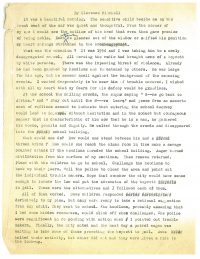
Meanwhile, the momentum of the movement was affecting Mitchell’s personal life in new and sometimes frightening ways. In his 1933 article about radicals, now over 20 years behind him, he wrote that the heroes of “human progress” would “root out injustice if it must be done at the expense of position, friendship, or personal safety.” In 1954, with the Supreme Court’s Brown v. Board decision putting the institution of segregation on notice, Mitchell now expected the same sacrifice from his 12-year-old son, Keiffer, though not without great anguish. In an account Mitchell wrote about the day he and his son integrated Gwynns Falls Park Junior High School, Mitchell revealed the depth of the torment he felt for his brave young son: “What could one do? How could one stand between him and a thrown brick? How could one reach the class room in time [to] make a counter attack if the hoodlums invaded the school building,” he asked, as he stared at the threatening white picketers outside of the school. “Anger burned civilization from the surface of my emotions,” he continued, using nearly identical language he once used to describe the “old savage” in that 1933 article. It is a poignant look inside the mind of a man who, like all of us, must decide what to do about the anger shaped by a perceived wrong. The first reaction, like that of the “old savage,” like that of Princip and Czolgosz and the white picketers outside of the schools across America, is violence. Mitchell shows that he’s made of stronger stuff, a trait he clearly passed on to his son, Keiffer. “Then reason returned,” he proclaimed,“Plead with the children to go to school. Challenge the hoodlums to back up their jeers. Call the police to clear the area and point out the individual trouble makers. Hope that somehow the city would have sense enough to invoke the law and put the advocates of the boycott in jail. These were the alternatives and I followed each of them.” Though he seemed to think of himself as a radical in those early days of youth, Mitchell exemplified all the ideals of American principles, even when the halls of Congress, the courts of justice, and law enforcement agencies were not on his side. Thankfully, at Gwynns Falls in 1954, they were.
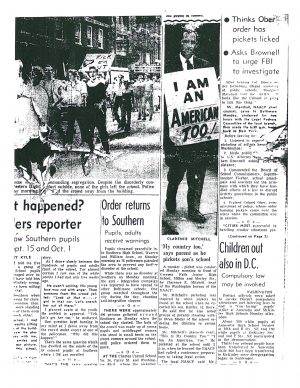
What his story does now show, however, due no doubt to Mitchell’s modest nature, is the lengths to which he went to integrate the school. Mitchell did not just plead with the children to go to school; he actively sought them out for recruitment. He and his wife, Juanita Mitchell, herself a fascinating civil rights figure, attended a PTA meeting at Booker T. Washington Junior High, Keiffer’s school prior to Gwynns Falls, to seek out other brave young children to help pioneer the integration movement. Altogether, Keiffer, along with 7 others, made the transfer. Mitchell accompanied his son for 6 weeks, and when, in October, he noticed the out-of-town license plates of the white picketers, he warned the school board that he would counter-picket, which he eventually did.[16]
Keiffer Mitchell received a mixed blessing for all of his courage. It was for Keiffer’s artistic interests that the Mitchells enrolled him in Gwynns Falls, in addition to stressing his responsibility as a young black man to integrate. There were clear advantages at the new school. Booker T. Washington was overcrowded, did not provide adequate nutrition and did not provide the materials to nourish his intellectual curiosities. At Gwynns Falls, he painted, and even designed the Christmas cover of the school paper. He was, however, the target of harassment- when he wasn’t being avoided. He was attacked on the playground on at least one occasion, and there was an incident on the bus where white children put lit cigarettes in his hood. But despite the difficulties he endured during desegregation, Keiffer went on to have a career in medicine.[17]
Civil Rights Legislation
Clarence Mitchell’s career, too, was marching toward its zenith. During this time of the late 50s and early 60s, a high level of collaboration was taking place between the NAACP, the National Council of Churches, and major Jewish secular organizations including the Anti-Defamation League, American Jewish Congress, and American Jewish Committee. The latter provided the NAACP with a great many resources, including legal help, funding, and political support. It was Mitchell’s job to fuse these groups into a lobbying tour-de-force in Congress. Mitchell, likely due to connections from his FEPC days, was able to bring Hispanic and Asian organizations into the LCCR fold.[18]
With civil disobedience taking over the streets of major American cities, Mitchell began to press the Kennedy Administration for a strong civil rights bill in early 1963. Kennedy’s show of support, although lacking in enforcement, roused southern opposition and violence, which was relayed by the press to a horrified and increasingly sympathetic nation. In June, Kennedy followed up with proposed legislation that had teeth, much more comparable to what Mitchell and other civil rights leaders were hoping for. When Kennedy was assassinated in November, Johnson picked up the torch and gave a rousing speech of his own to Congress, pushing the body to pass Kennedy’s LCCR-backed bill.
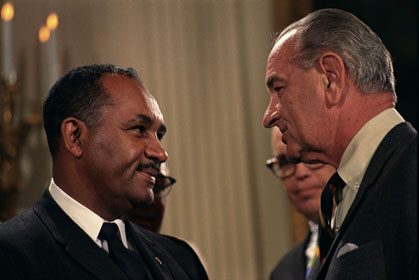
Mitchell’s strategy, as chief lobbyist for the NAACP and legislative chairman of the LCCR, was to divide and conquer. During the late 1950s, southern Democrats and midwestern Republicans consistently joined forces to block civil rights legislation. He would have to separate Republican moderates from this coalition and rely on the presidential leadership of Johnson to coax Democrats away from southern influence. This was particularly important once Mitchell was invited to strategy meetings with the president, whom Mitchell convinced to use his considerable influence to move the bill out of the two house committees in which civil rights bills often went to die: the House Rules Committee, headed by Howard Smith, and the Senate Judiciary Committee, headed by Jim Eastland. Both Smith and Eastland were segregationist southerners.[19]
Once the bill moved to the floor of the House, Mitchell and his staff ensured that his supporters in the chamber were on the floor during critical votes, and watched vigilantly for amendments aimed at weakening the bill. It was eventually passed in February. The Senate floor, of course, included the long, dreaded, and inevitable filibuster. The NAACP’s state conferences urged their coalition allies, particularly the labor unions and religious groups, to press swing vote senators in every encounter, with phrases like “do the right thing,” to vote for cloture.[20] It is a testament to their work in fighting Rule 22 that the vote for cloture passed well beyond the necessary threshold.
After two decades, Mitchell and others who fought for a permanent FEPC finally saw their work realized in the Civil Rights Act of 1964, which established the Equal Employment Opportunity Commission, or EEOC. He continued his resolute faith in enacting legislative solutions to civil rights struggles by utilizing his strategic lobbying for the passage of the 1965 Voting Rights Act and the 1968 Fair Housing Act.
Maintaining and Broadening the Movement’s Principles
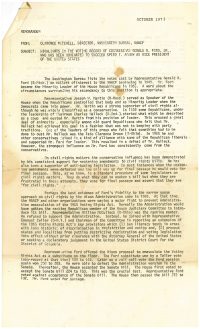
But despite the legislative successes, Mitchell knew from experience that legislation was only as good as its enforcement, and he began launching campaigns to ensure just that.[21] For this, he would need the cooperation of the executive branch. Mitchell’s relationship with Lyndon Johnson had been an easy one, as well as productive—ironic, as Johnson was one of those southern Democrats that so often opposed civil rights legislation. Johnson’s agenda was conveniently aligned with his own, a mix between New Deal and Great Society reforms. Richard Nixon, a Republican, was overall supportive but always considered by Mitchell to be an “enigma.” As vice president in 1956, Nixon supported the Civil Rights Act of 1957; as President, he extended the 1965 Voting Rights Act in 1970 and sought to end discrimination in private enterprises such as construction.[22]
Gerald Ford was even more enigmatic. As a congressman, Ford flip-flopped on issues of civil rights, which Mitchell described as “a narrow gauge approach” in which he opposed legislation at first and only voted in favor when its passage was inevitable. Mitchell expressed in his memos that he was suspicious of Ford’s rise to power. Nevertheless, Ford too supported the extension of voting rights in 1975 and supported the EEOC in a time of turmoil.[23]
As Mitchell’s career began to wind down in the late 70s, he took on tasks that were even greater in scope. In 1975, he accepted a position as U.S. delegate to the 7th special session and 30th regular session of the United Nations. In a prepared statement Mitchell read to a UN Congressional Hearing in March of 1976, he showcased the level-headed, enlightened leadership that made him such a respected figure throughout the movement, by blacks and whites alike, and such an effective lobbyist for change. He also reinforced the expanded vision of his principles beyond mere self-interest. His concerns are not simply for black Americans, but for all the people of the world who are without homes, adequate food, and who are the victims of injustice.
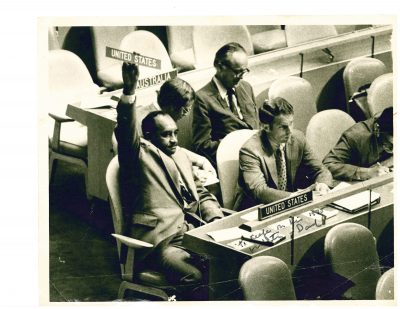
“Resolutions that condemn, that accuse, that anathematize do not bring us any nearer to agreement. They have the opposite effect,” he read. He went on:
“…there was a common theme coming from the developing countries. Briefly, they were saying that they wanted fair payment for their raw products, fair prices for manufactured goods that they had purchased from the developed countries and international cooperation in preventing outside manipulation that undermines their economies. These are reasonable aspirations and we must continue to try to meet them. If we implement fully the programs and suggestions approved at the special session, we should see more food for the hungry, a general raising of technological knowledge, exploitation of the wealth of the ocean floor for all of the people of the world and a lessening of tension between those nations that are classified as haves and those classified as have nots…
“During the thirtieth session it was my good fortune to study and participate in action on various subjects of interest to our country. These included cooperation between the United Nations and the organization of African unity, peace keeping activities, disaster relief, racial discrimination, status of the International Covenant on Economic, Social and Cultural Rights, problems in Southern Africa, elimination of all forms of racial discrimination, elimination of all forms of religious intolerance, report of the International Law Commission, succession of states in respect to treaties diplomatic asylum and many others…”
Mitchell, having stuck to his principles throughout his career, knew the value of, not simply maintaining a positive image, but of actually adhering to principled policy. By adhering to the goals and ideals of America, on the justice with which it was founded, a certain moral authority could be formulated, and this nation could truly become that ‘shining city.’
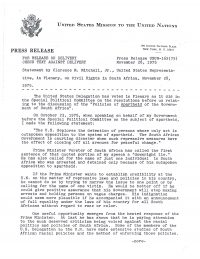
“It is my opinion that the most valuable lesson we can learn… is the need to improve our image with the developing countries so that they will look to us for guidance and follow our leadership on moral issues that confront today’s world. These include… the stamping out of oppressive rule of majorities by arrogant minorities… one of the most valuable assets of the United States is its concern for human rights. We have a commitment to preserve due process, fair play and actions based on moral value rather than on expediency and selfish Interest. If we pay more attention to developing these assets at home, we will be in a better position to export it abroad, especially through the United Nations.
“No matter how lofty our expressions may be on the floor of the General Assembly, no matter how attractive our promises of cooperation may sound, if we ignore the needs of the developing nations, if we close our eyes to injustices that are inflicted upon Jews who seek to emigrate from the Soviet Union, or Blacks who are under the heel of tyranny in Namibia, Rhodesia and Southern Africa, what we say at the United Nations will have little meaning. If we follow a policy of expediency through alliances and understandings with police states at the expense of the friendship and support of those who try to follow the ideals of democracy, we will not attract the kind of understanding and cooperation needed for the survival of the human race.”[24]
Final Years
In 1980, Clarence Mitchell was awarded the Medal of Freedom by President Jimmy Carter, the highest honor given to a civilian, but this paled in comparison to the level of admiration and respect he had earned through a long, rewarding career, one that, in the end, saw the greatest progress for African Americans since emancipation from slavery during the Civil War a century earlier.
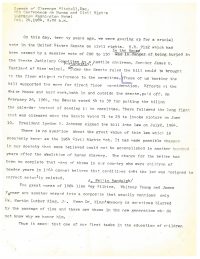
In a speech given to the NEA Conference on Human and Civil Rights, twenty years to the day after the Senate voted on the 1964 Civil Rights Act, Clarence Mitchell reflected on that great achievement. “The change for the better has been so complete,” he imparted, “that many of those in our country who were children of tender years in 1964 cannot believe that conditions that the law was designed to correct actually existed.” He went on to mention great names of the movement—A. Philip Randolph, Roy Wilkins, Whitney Young, James Farmer—and expressed regret that these names are often “merged into a composite that usually mentions only Dr. Martin Luther King, Jr.” “Thus,” he urged, “it seems that one of our first tasks in the education of children is to teach them where we were as a nation before 1964 and how we have gotten to where we are now.”
There is an anecdote within this speech that essentially sums up Mitchell’s entire life’s work. He describes the mayor of Detroit giving “black policemen opportunities to be promoted on merit,” reflecting Mitchell’s work with the FEPC training and employing black workers in public jobs, and it also portrays the importance of having black elected officials, something Mitchell knew from his youth. The decision of the mayor was upheld in both District and Circuit courts, by two judges who were also black. Representation in government, Mitchell’s own first “act of radicalism,” had, toward the end of his life, become a reality. Through his faith in these institutions, the American system of justice was now closer to providing just that, instead of serving to provide the opposite.
“Finally,” he concludes, “I will say a word about that activity that is perhaps closest to my heart. It is political action… In the south and throughout the country there is a rising tide of interest in seeking public office. There is an equal determination to elect qualified candidates and also to make certain that from the highest office, which is the presidency, down to the most obscure county official we will give early and effective support to those candidates who stand for equal justice and freedom for all of people of whatever race, sex, national origin, age or religion. This is the star toward which we must continue to reach. When we have men and women in public office who care about the hungry, who work for sheltering those who have no homes, who want a living wage for even the lowest persons in the work force, who want to end ignorance by supporting education, who want to provide health care of the sick and economic security for the aged we will be able to reach that star. When we do that the world will be a better place because we have set the right example of how humans should live together.”
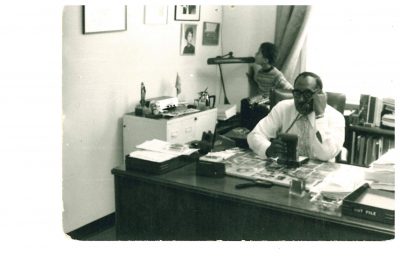
Although vote counting, lobbying, and well-reasoned debates on the floors of Congress don’t have the dramatic appeal of impassioned speeches and marches, it was these actions taking place behind the scenes that got the votes to pass the laws. It is the nuts and bolts of democracy, the essential process of American politics, and, as a result, the necessary path toward change. Without heroes like Clarence Mitchell walking that path, without his commitment to American institutions and ideals in the face of blatant contradictions in policy, without his calm rationale, patience, and clear understanding of right and wrong, it is unclear whether the movement would have gotten as far as it did, when it did. It was traits like these that made him perhaps the only person suitable for this role.
Where would we be without radicals? My answer to that would depend on the type of radical in question. Those who would use violence, like Princip or Czolgosz, usually only succeed in rousing reactionary violence and often suppression by those seeking to preserve the offending traditions, as Mitchell pointed out in his 1933 article. Those who seek the moral high-ground, those concerned with the rights of everyone, that “valuable asset of the United States” Mitchell so fondly referred to in the UN Congressional Hearing, will find that observing that moral principle will lead to achievements that last, because they will always find support among those of us in America who believe in its just cause.
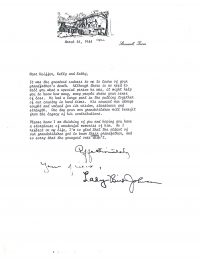
After Mitchell’s death in 1984, Keiffer Mitchell, Jr. wrote a school essay about his legendary “grandpop.” In it, he describes helping his grandmother in a grocery store, and looking out of the window to see his grandfather talking to a young black man. “Did this young man realize,” Keiffer, Jr. wondered, “he was talking to the great Civil Rights lobbyist who pushed the famous 1964 Civil Rights Act through Congress that would change the way he and the future generations live?”
In honor of Clarence Mitchell, Jr., in making sure his role and his memory are not thrown in the composite of Dr. King, great though it is, the U.S. Capitol Historical Society proudly does its part to make sure we do not forget.
[1] CZOLGOSZ DIES FOR HIS CRIME. (1901, Oct 30). Chicago Daily Tribune (1872-1922) Retrieved from https://proxyau.wrlc.org/login?url=https://search-proquest-com.proxyau.wrlc.org/docview/172973159?accountid=8285
[2] In an address on the first anniversary of the Alliance for Progress, 13 March 1962, taken from https://www.jfklibrary.org/Asset-Viewer/Archives/JFKPOF-037-026.aspx
[3] Watching the big parade. (1945, Nov 24). Afro-American (1893-1988) Retrieved from https://proxyau.wrlc.org/login?url=https://search-proquest-com.proxyau.wrlc.org/docview/531516642?accountid=8285
[4] Watson, D. L. (1990). Lion in the lobby : Clarence Mitchell, Jr.’s Struggle for the Passage of Civil Rights Laws. P. 88. New York: Morrow.
[5] Ibid.
[6] Ibid; p.115-122
[7] Watson, D. L. (2005). The Papers of Clarence Mitchell Jr. Volume I: 1942-1943. Athens: Ohio University Press.
[8] Gregory, J. N. (2006). The Southern Diaspora: How the Great Migrations of Black and White Southerners Transformed America. University of North Carolina Press.
[9] Watson, D. L. (2002). The Papers of the “101st Senator”: Clarence Mitchell Jr. and Civil Rights. The Historian, 634.
[10] Ibid, Gregory, p.267
[11] Schultz, K. M. (2008). The FEPC and the Legacy of the Labor-Based Civil Rights Movement of the 1940s. Labor History, 71-92.
[12] Watson, D. L. (2005). The Papers of Clarence Mitchell Jr. Volume I: 1942-1943. Athens: Ohio University Press.
[13] Watson, D. L. (2005). The Papers of Clarence Mitchell Jr. Volume II, 1944-1946. Athens: Ohio University Press.
[14] Lorence, J. (2009). The Workers Alliance and a United Front: Jobless Workers Organize, 1937-1938. In The Unemployed People’s Movement: Leftists, Liberals, and Labor in Georgia, 1929-1941 (pp. 165-188). University of Georgia Press.
[15] Ibid, Schultz
[16] Baum, H. S. (2010). “Brown” in Baltimore: School Desegregation and the Limits of Liberalism. Pgs. 82-87. Cornell University Press.
[17] Ibid, 88.
[18] Jonas, G. (2005). Freedom’s Sword: The NAACP and the Struggle Against Racism in America, 1909-1969. Pg. 182-183. New York: Routledge.
[19] Jonas, G. (2005). Freedom’s Sword: The NAACP and the Struggle Against Racism in America, 1909-1969. Pg. 193-200. New York: Routledge.
[20] Ibid, p.193.
[21] Watson, D. L. (2002). The Papers of the “101st Senator”: Clarence Mitchell Jr. and Civil Rights. The Historian, 637
[22] Ibid, 639-640.
[23] Ibid, 640.
[24] From United Nations Congressional Hearing, Mar. 2, 17, 18, 25, 1976, U.S. Congress. Senate Committee on Foreign Relations.
